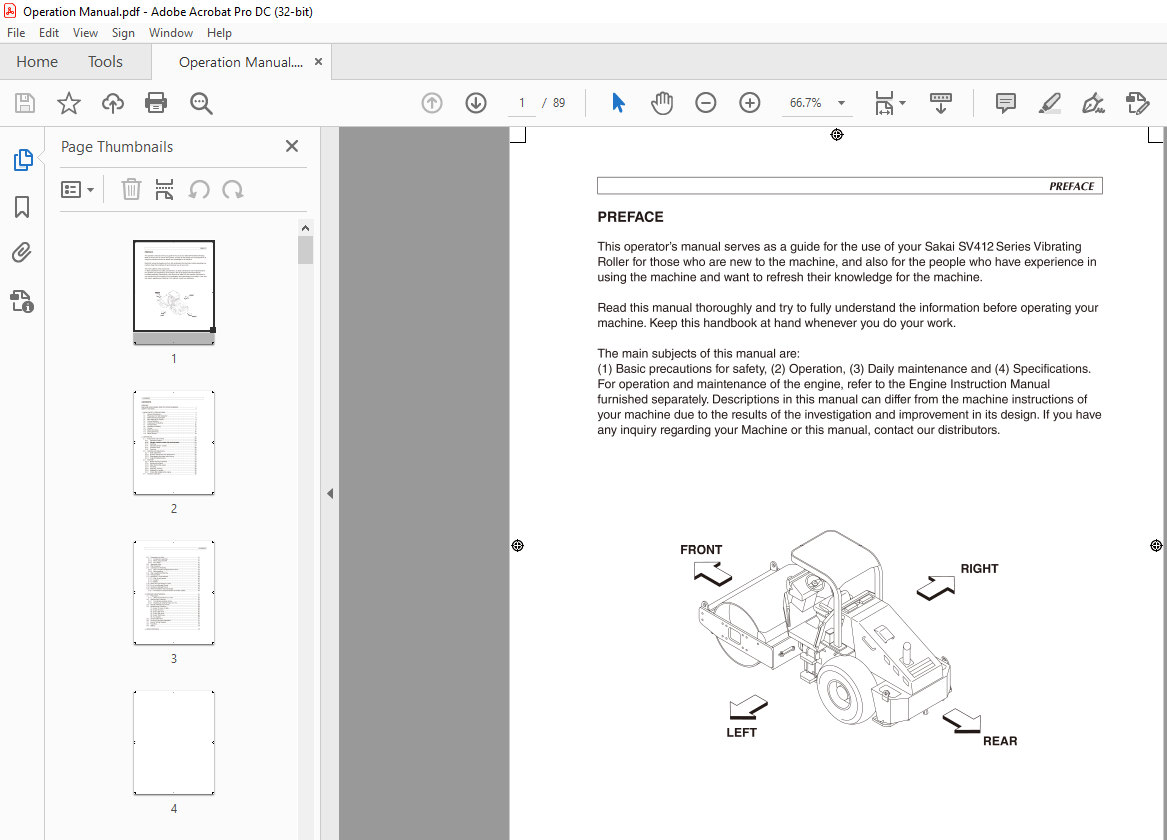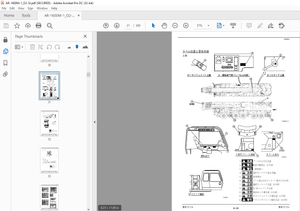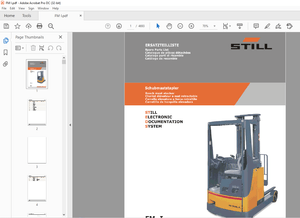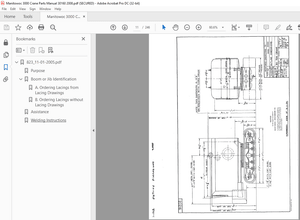$25.95
Sakai SV412 Series Vibrating Roller Operation Manual - PDF
Sakai SV412 Series Vibrating Roller Operation Manual – PDF DOWNLOAD
The Sakai SV412 Series Operation Manual is essential for operation. Covering SV412 vibrating rollers, it ensures efficient usage and maintenance.
FILE DETAILS:
Sakai SV412 Series Vibrating Roller Operation Manual – PDF DOWNLOAD
Language : English
Pages : 89
Downloadable : Yes
File Type : PDF
DESCRIPTION
Sakai SV412 Series Vibrating Roller Operation Manual – PDF DOWNLOAD
PREFACE
- This operator’s manual serves as a guide for the use of your Sakai SV412 Series Vibrating Roller for those who are new to the machine, and also for the people who have experience in using the machine and want to refresh their knowledge for the machine.
- Read this manual thoroughly and try to fully understand the information before operating your machine. Keep this handbook at hand whenever you do your work.
- The main subjects of this manual are:
- (1) Basic precautions for safety,
- (2) Operation,
- (3) Daily maintenance and
- (4) Specifications.
- For operation and maintenance of the engine, refer to the Engine Instruction Manual furnished separately. Descriptions in this manual can differ from the machine instructions of your machine due to the results of the investigation and improvement in its design. If you have any inquiry regarding your Machine or this manual, contact our distributors.
IMAGES PREVIEW OF THE MANUAL:


TABLE OF CONTENTS:
Sakai SV412 Series Vibrating Roller Operation Manual – PDF DOWNLOAD
CONTENTS
PREFACE
MACHINE AND ENGINE IDENTIFICATION NUMBERS.1
SAFETY NOTICES 2
1BASIC SAFETY PRECAUTIONS4
1.1 General Precautions 4
1.2 Preparation for Safe Operation 7
1.3 Before Starting the Engine 8
1.4 After Starting the Engine.9
1.5 During Operation 9
1.6 Loading and Unloading 12
17 Transportation 12
1.8 Handling the Battery .13
1.9 Towing .14
1.10 Before Servicing 14
1.11 During Servicing 16
1.12 Safety Decals .18
2OPERATION .20
2.1 Instruments and Controls 20
2.1.1 Operator’s station .20
2.1.2 Gauges, indicator lamps and warning lamps .21
2.1.3 Switches 24
2.1.4 Operating levers / pedals 27
2.1.5 Unloader valve .28
2.1.6 Fuse box .28
2.2 Handling and Adjustments 29
2.2.1 Seat adjustment .29
2.2.2 Scraper adjustment and replacement 30
2.2.3 Disengaging the brake when towing .31
2.2.4 Engine troubleshooting 32
2.3 Operation 33
2.3.1 Before-starting inspection 33
2.3.2 Starting the engine 34
2.3.3 After starting the engine .36
2.3.4 Traveling 36
2.3.5 Stopping / Parking .38
2.3.6 Stopping the engine .39
2.37 Check after stopping the engine .39
2.4 Vibratory Operation .40
CONTENTS
2.5 Precautions for Work 41
2 5.1 Compaction operation .41
2.5.2 When going downhill 41
2.5.3 On a slope .41
2.6 Applicable Jobs 42
2.7 After Operation 43
2.8 Loading and Unloading .44
2.8.1 Use of a trailer equipped with a winch 44
2.8.2 Self-propelling 45
29 After Loading the Machine 46
2.1 0 Transportation 46
2.11 Operation in Cold Weather 46
2.11.1 Fuel oil and grease .46
2.11.2 Coolant .46
2.11.3 Battery 47
2.12 When the Cold Season is Over .48
2.13 For a Long Storage Period 48
2.14 During the Storage Period 48
2.15 When the Battery Has Discharged .49
2.15.1 Connection and disconnection of booster cables .49
3PERIODIC MAINTENANCE .51
3.1 Precautions 51
3.1.1 Lifting the machine on a hoist .53
3.2 Walk-around Checking 54
3.2.1 Tire inflation pressure check 55
3.2.2 Checking for external injury to a tire 55
3.3 Periodic Maintenance Points .56
3.4 Maintenance Procedure 58
(1) Every 10 hours or daily .58
(2) Every 50 hours .60
(3) Every 250 hours .62
(4) Every 500 hours 64
(5) Every 1000 hours 66
(6) As needed .68
3.5 Consumable Parts 72
3.6 Fluid and Lubricant Capacities .74
3.7 Electric Wiring Diagram 76
3.8 Fuse Box 78
3.9 Battery 78
4SPECIFICATIONS .79



